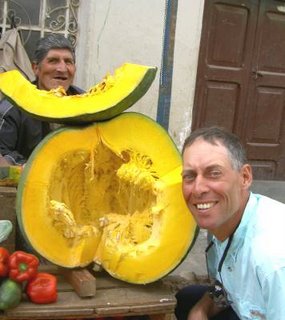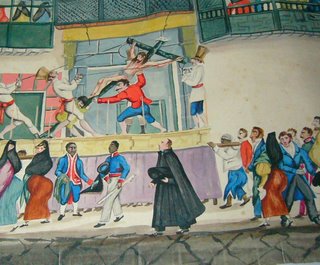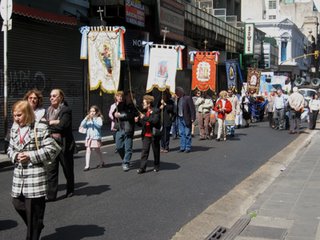10.31.2006
Happy Halloween & Canción Criolla Day
Happy Halloween, y'all.

Halloween shopping in Sao Paulo, Brazil. Photo by kevinfmchugh1.

Halloween performance by Colectivo Etereo, Santiago, Chile. Note the DJ's andean costume. Photo by Tubatuba.
And for mis Perucos: a hearty Feliz día de Canción Criolla! Thanks to Alejandro at Peru Food, we have a terrific montage of the great masters of this very Peruvian musical form:

Halloween shopping in Sao Paulo, Brazil. Photo by kevinfmchugh1.

Halloween performance by Colectivo Etereo, Santiago, Chile. Note the DJ's andean costume. Photo by Tubatuba.
And for mis Perucos: a hearty Feliz día de Canción Criolla! Thanks to Alejandro at Peru Food, we have a terrific montage of the great masters of this very Peruvian musical form:
10.08.2006
Crema de Zapallo

Crema de Zapallo, served with rice. Photo by Don Ball.
I was never a huge fan of squash, at least not the way I grew up eating it: acorn squash cut in halves and baked with butter and brown sugar. (That actually sounds appealing as I type it...but in practice has never been my favorite.)
In soup form, however, squash really floats my boat. The other day, I took a buttercup squash and did it up Peruvian style to make "Crema de Zapallo," a.k.a Cream of Pumpkin Soup.

Buttcup squash. Photo by Don Ball.

Peruvian zapallo. Photo courtesy PAC Tour.
Pumpkin (zapallo) in Lima is different than the North American variety. The outside is green and the flesh is a pale yellow. I haven't tried it, but I suspect that your garden variety orange pumpkin wouldn't work in this recipe. It's simply not rich enough. On the other hand, I think the buttercup sqash is a good subsitute for zapallo. Cooked, this squash is rich and has a fine texture when pureed.
Here's a simplified recipe for my Crema de Zapallo.
- 1 med. white onion
- 3 cloves garlic
- 1 Tbsp. ground cumin
- 2 Tbsp. cooking oil
- 2 Tbsp. aji amarillo paste
- 1 tsp. black pepper
- 2 tsp. kosher salt
- 1 buttercup squash
- 1 can evaporated milk
- 1 liter chicken broth
Separately, heat the oil and add diced onions and a couple pinches of salt. Fry the onions for a few minutes until golden. Add garlic, aji, cumin, pepper and remaining salt. Fry for another couple minutes. Add this mixture to the squash.
Add evaporated milk and cook another 20-30 minutes as needed to acheive desired consistency. I left my soup a teeny bit runny and served it with rice. Serve in a large shallow bowl with shaved fresh parmesan over top.
Tags: Zapallo, pumpkin, squash, soup, cooking, recipes, Peru, aji amarillo, cumin
10.05.2006
Beauty pageant for mules

Contestants line up for judging. Photo courtesy 20 Minutes.
A mule is someone who smuggles drugs by swallowing condom-wrapped drugs and then, er, evacuating the drugs upon arrival at their destination. It's a sad fact that mules are usually not hardened criminals, but desperate individuals motivated by threats or extreme circumstances.
In Peru's Santa Monica women's prison, accused and convicted mules recently participated in a beauty pageant. The event was covered by France's 20 Minutes. Blogger Robert translated the captions from a photo essay. Highlights follow:
On October 3rd, the women's prison of Santa Monica in Lima, Peru, organized the finale of the beauty contest called "Miss Spring" of which all the participants are inmates. Nearly all of the participants in the contest are mules, women who swallow capsules of cocaine for trafficking abroad -- mostly, Europe or the US. Among the 11 finalists, many nationalities are represented, notably Bolivia, Thailand, Belgium, and Mexico.via Boing Boing
According to the director of the prison, this contest doesn't just rate the women on their physique, though sex appeal is important. It also judges the women on their feminity and their value as a person. The winner last year, On Uma Chumsri from Thailand, is present at the contest. She has been in Santa Monica prison since 2004, still awaiting trial. This year the winner is the beautiful Koku Kasusura from Holland.
Of the 32,397 inmates incarcerated in Peru, more than 700 are foreigners, the majority of which have been implicated in some form of drug trafficking.
Religious processions
Professional tourguide, foodie, wine-lover, architecture freak and blogger Robert Wright keeps a terrific blog, Line of Sight, which details his life in Buenos Aires. He recently posted the photo below and commented:
Robert's photo got me to thinking that I am yet to see one of Lima's famous religious processions. As my I've been told, these are often monumental, day-long events, involving tens of thousands of people in a relatively small area, often funnelling down narrow, colonial streets. Needless to say, such a manifestation chokes the downtown streets for hours. Not that anyone's trying to get anywhere. On major religious holidays, the country essentially shuts down. If you're not in the procession, at church or home with family, you're undoubtedly a tourist.
What's our equivalent? Probably not Macy's parade, because the scale and pageantry of that event is determined by corporate largesse. Mardi Gras in New Orleans might be a closer (albeit irreverent) match. There, the procession is fueled not so much by marketing dollars but by the creative participation of krewes and individuals.
I've seen a few processions in Cusco and the environs. There, it seems that the border is blurred between Catholicism and the ancient but tenacious Andean religious beliefs. In the same event, it's not surprising to see a saint or virgen on a silver-crusted "anda", or platform, as well as individuals dressed in native masks and costumes.

Corpus Cristi procession, Cusco 1999. Photo by Don Ball.
I'm not Catholic, but I have to say that even a small procession can be a mind-blowing experience. Once, in Urubamba, we were returning to our hotel from a restaurant and had to walk through a part of town that inexplicably had no power. On a pitch-black street, we met up with a religious procession -- some 100 people singing hymns a capella, each singer holding one small candle. We ducked into a doorway and watched and listened as the procession shuffled past us. It gave me goose bumps then and still does to this day when I think of it.
Anyway, as a point of contrast to Robert's photo from Buenos Aires, below is a capture of one of Lima's lesser events in the religious calendar: Virgen de la Puerta. From what I gather (happy to be corrected), it's not an unimportant celebration, but it's also not on the level of, say, Señor de los Milagros.

Virgen de la Puerta procession, Lima 2005. Photo by manarh.
Finally, I found an interesting painting that depicts a holy-week procession in Lima during the early 1800s. It's interesting to see that the artist has depicted people of different races and classes in the same scene. Note that the porters carrying the platform appear to be black and poor (when was slavery abolished in Peru?) while a few paces away we see something rare for the time: two wealthy black men.

"Holy Week Procession in Lima", watercolor by Francisco Fierro, ca. 1832. Courtesy of the Hispanic Society of America.
Tags: Robert Wright, Buenos Aires, Line of Sight, Religious processions, Nuestra Senora de la Piedad, Lima, Peru, Cusco, Urubamba, Corpus Cristi, Senor de los Milagros, Virgen de la Puerta, Holy Week, Francisco Fierro.
"It’s rare to find a religous procession in Buenos Aires. In spite of Argentina being a mainly Catholic country, processions are nowhere as frequent as in Spain. Nor as fancy. While wandering around Congreso & photographing old street signs for a new walking tour logo design, I ran into a procession. Less than 100 people were taking Nuestra Señora de la Piedad around her yearly route downtown. Hardly impressive but unique for BA."
Religious procession in Buenos Aires. Photo by Robert Wright.
Robert's photo got me to thinking that I am yet to see one of Lima's famous religious processions. As my I've been told, these are often monumental, day-long events, involving tens of thousands of people in a relatively small area, often funnelling down narrow, colonial streets. Needless to say, such a manifestation chokes the downtown streets for hours. Not that anyone's trying to get anywhere. On major religious holidays, the country essentially shuts down. If you're not in the procession, at church or home with family, you're undoubtedly a tourist.
What's our equivalent? Probably not Macy's parade, because the scale and pageantry of that event is determined by corporate largesse. Mardi Gras in New Orleans might be a closer (albeit irreverent) match. There, the procession is fueled not so much by marketing dollars but by the creative participation of krewes and individuals.
I've seen a few processions in Cusco and the environs. There, it seems that the border is blurred between Catholicism and the ancient but tenacious Andean religious beliefs. In the same event, it's not surprising to see a saint or virgen on a silver-crusted "anda", or platform, as well as individuals dressed in native masks and costumes.

Corpus Cristi procession, Cusco 1999. Photo by Don Ball.
I'm not Catholic, but I have to say that even a small procession can be a mind-blowing experience. Once, in Urubamba, we were returning to our hotel from a restaurant and had to walk through a part of town that inexplicably had no power. On a pitch-black street, we met up with a religious procession -- some 100 people singing hymns a capella, each singer holding one small candle. We ducked into a doorway and watched and listened as the procession shuffled past us. It gave me goose bumps then and still does to this day when I think of it.
Anyway, as a point of contrast to Robert's photo from Buenos Aires, below is a capture of one of Lima's lesser events in the religious calendar: Virgen de la Puerta. From what I gather (happy to be corrected), it's not an unimportant celebration, but it's also not on the level of, say, Señor de los Milagros.

Virgen de la Puerta procession, Lima 2005. Photo by manarh.
Finally, I found an interesting painting that depicts a holy-week procession in Lima during the early 1800s. It's interesting to see that the artist has depicted people of different races and classes in the same scene. Note that the porters carrying the platform appear to be black and poor (when was slavery abolished in Peru?) while a few paces away we see something rare for the time: two wealthy black men.

"Holy Week Procession in Lima", watercolor by Francisco Fierro, ca. 1832. Courtesy of the Hispanic Society of America.
Tags: Robert Wright, Buenos Aires, Line of Sight, Religious processions, Nuestra Senora de la Piedad, Lima, Peru, Cusco, Urubamba, Corpus Cristi, Senor de los Milagros, Virgen de la Puerta, Holy Week, Francisco Fierro.





